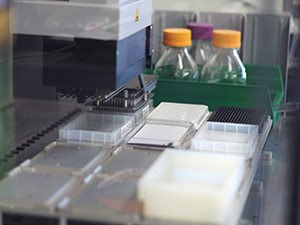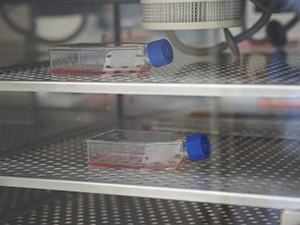The Laboratory is supported by Drs. Frick and Arnold. Both have worked closely with the NCATS program and developed primary, secondary and tertiary screening assays.

Although commercially available screening libraries are available, such as LOPAC, Chembridge, the NIH clinical collection, and the NCI mechanistic set, our center focuses on screening compounds that were produced at UWM or in collaboration with other institutes. These include thiazoles, oxazoles, imidazodiazepines, 3-indolylmethanamines, benzothiazoles, and nucleotide analogs. The facility is using standard 96 and 384 well plate formats for screening compounds and applies pin tools for compound transfers. Automation is accomplished with liquid handlers such as Tecan EVO150 system and EpMotion 5070 workstation. An integrated Tecan M1000 plate reader supports absorbance, fluorescence, FRET, fluorescence polarization, luminescence and BRET detection. Other plate readers include a BMG POLARstar Omega 384-well plate reader with two reagent injectors, a Thermo Multiskan Ascent absorbance plate reader, and a 96-well Varian Cary Eclipse fluorescence spectrophotometer. A 96-well Mastercycler ep Realplex Quantitative Realtime PCR System is available for high-throughput PCR and protein stability assays.
Early Drug Discovery

In silico screening is support of MOE (Molecular Operating Environment), AutoDock Vina, and UCSF Dock. Virtual libraries have been procured and from open source (ZINC) and commercial vendors such as ChemBridge, Life Chemicals, and and ChemDiv. In addition, we have focused virtual libraries of compound that can be made at UWM using existing protocols.
Physiochemical compound properties such as solubility, permeability and logD can be calculate but the center has an excellent laboratory setup to measure these properties using a 96-well format. Early toxicology is determined with viability assays that support more than fifty tumor derived and stable mammalian cell lines. Detection is based on fluorescence or luminescence.
Phase I and II in vitro metabolism is carried out in conjunction with tandem mass spectrometry at the Shimadzu Analytical Instrumentation Laboratory and Research Center. Mammalian liver, kidney and intestine microsomes and S9 fractions are available and phase I oxidation and phase II glucuronidation and glucosidation assays have been optimized. In conjunction the Center of Synthesis and Lead Development, metabolites standards can be generated supporting identification and quantification.